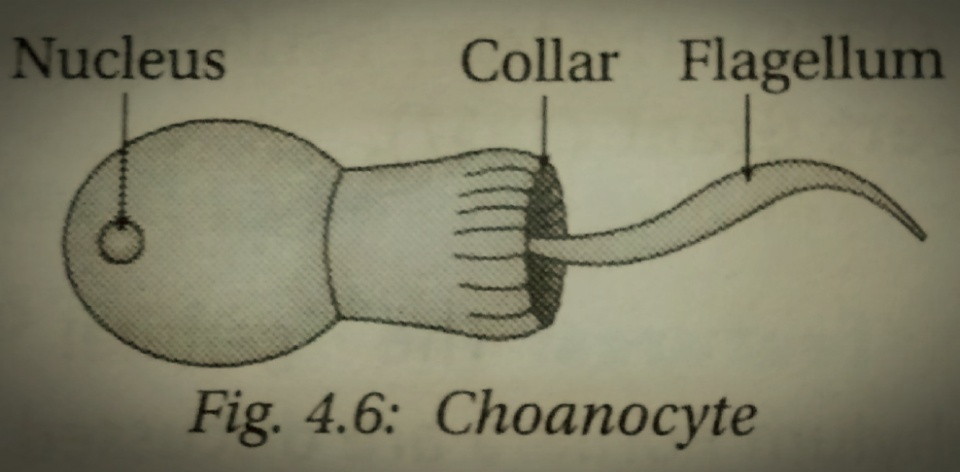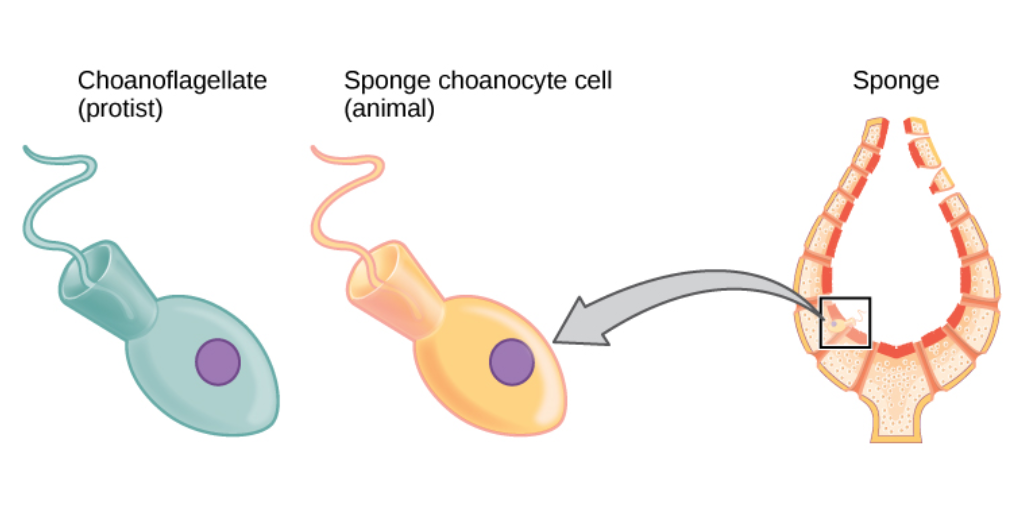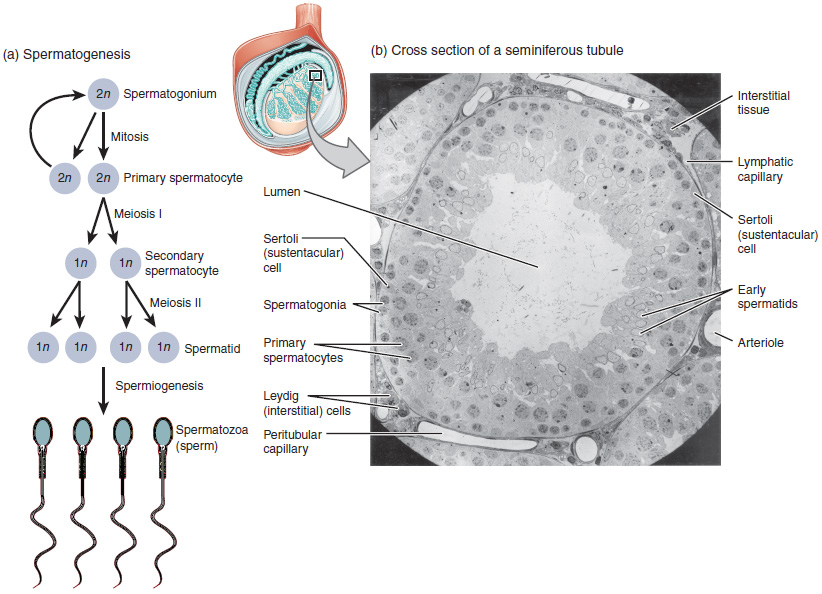|
Choanocytes
Choanocytes (also known as "collar cells") are cells that line the interior of asconoid, syconoid and leuconoid body types of sponges that contain a central flagellum, or ''cilium,'' surrounded by a collar of microvilli which are connected by a thin membrane. They make up the choanoderm, a type of cell layer found in sponges. The cell has the closest resemblance to the choanoflagellates which are the closest related single celled protists to the animal kingdom (metazoans). The flagellae beat regularly, creating a water flow across the microvilli which can then filter nutrients from the water taken from the collar of the sponge. Food particles are then phagocytosed by the cell. Anderson, D. (2001) ''Invertebrate Zoology'' Oxford University Press Location Choanocytes are found dotting the surface of the spongocoel in asconoid sponges and the radial canals in syconoid sponges, but they comprise entirely the chambers in leuconoid sponges. Function By cooperatively moving their ... [...More Info...] [...Related Items...] OR: [Wikipedia] [Google] [Baidu] |
Sea Sponge
Sponges, the members of the phylum Porifera (; meaning 'pore bearer'), are a basal animal clade as a sister of the diploblasts. They are multicellular organisms that have bodies full of pores and channels allowing water to circulate through them, consisting of jelly-like mesohyl sandwiched between two thin layers of cells. Sponges have unspecialized cells that can transform into other types and that often migrate between the main cell layers and the mesohyl in the process. Sponges do not have nervous, digestive or circulatory systems. Instead, most rely on maintaining a constant water flow through their bodies to obtain food and oxygen and to remove wastes. Sponges were first to branch off the evolutionary tree from the last common ancestor of all animals, making them the sister group of all other animals. Etymology The term ''sponge'' derives from the Ancient Greek word ( 'sponge'). Overview Sponges are similar to other animals in that they are multicellula ... [...More Info...] [...Related Items...] OR: [Wikipedia] [Google] [Baidu] |
Asconoid
Sponges, the members of the phylum Porifera (; meaning 'pore bearer'), are a basal animal clade as a sister of the diploblasts. They are multicellular organisms that have bodies full of pores and channels allowing water to circulate through them, consisting of jelly-like mesohyl sandwiched between two thin layers of cells. Sponges have unspecialized cells that can transform into other types and that often migrate between the main cell layers and the mesohyl in the process. Sponges do not have nervous, digestive or circulatory systems. Instead, most rely on maintaining a constant water flow through their bodies to obtain food and oxygen and to remove wastes. Sponges were first to branch off the evolutionary tree from the last common ancestor of all animals, making them the sister group of all other animals. Etymology The term ''sponge'' derives from the Ancient Greek word ( 'sponge'). Overview Sponges are similar to other animals in that they are multicellular, h ... [...More Info...] [...Related Items...] OR: [Wikipedia] [Google] [Baidu] |
Choanocyte
Choanocytes (also known as "collar cells") are cells that line the interior of asconoid, syconoid and leuconoid body types of sponges that contain a central flagellum, or ''cilium,'' surrounded by a collar of microvilli which are connected by a thin membrane. They make up the choanoderm, a type of cell layer found in sponges. The cell has the closest resemblance to the choanoflagellates which are the closest related single celled protists to the animal kingdom (metazoans). The flagellae beat regularly, creating a water flow across the microvilli which can then filter nutrients from the water taken from the collar of the sponge. Food particles are then phagocytosed by the cell. Anderson, D. (2001) ''Invertebrate Zoology'' Oxford University Press Location Choanocytes are found dotting the surface of the spongocoel in asconoid sponges and the radial canals in syconoid sponges, but they comprise entirely the chambers in leuconoid sponges. Function By cooperatively moving ... [...More Info...] [...Related Items...] OR: [Wikipedia] [Google] [Baidu] |
Choanoderm
The choanoderm is a type of cell layer composed of flagellated collar cells, or choanocytes, found in sponges. The sponge body is mostly a connective tissue; the mesohyl, over which are applied epithelioid monolayers of cells, the outer pinacoderm and the inner choanoderm. Importance Most aspects of sponge biology, including feeding, reproduction, and gas exchange, depend on a low pressure flow of water generated by the flagella A flagellum (; ) is a hairlike appendage that protrudes from certain plant and animal sperm cells, and from a wide range of microorganisms to provide motility. Many protists with flagella are termed as flagellates. A microorganism may have f ... of the choanoderm. Three grades of organization, asconoid, syconoid, and leuconoid, reflect the degree of elaboration of the choanoderm layer and mesohyl. In the asconoid plan the interior water space, or atrium, is large and unpartitioned. In the syconoid plan the periphery of the atrium is divided in ... [...More Info...] [...Related Items...] OR: [Wikipedia] [Google] [Baidu] |
Choanoflagellates
The choanoflagellates are a group of free-living unicellular and colonial flagellate eukaryotes considered to be the closest living relatives of the animals. Choanoflagellates are collared flagellates, having a funnel shaped collar of interconnected microvilli at the base of a flagellum. Choanoflagellates are capable of both Asexual reproduction, asexual and sexual reproduction. They have a distinctive cell morphology (biology), morphology characterized by an ovoid or spherical cell body 3–10 Micrometre, µm in diameter with a single apical flagellum surrounded by a collar of 30–40 microvilli (see figure). Movement of the flagellum creates water currents that can propel free-swimming choanoflagellates through the water column and trap bacteria and detritus against the collar of microvilli, where these foodstuffs are engulfed. This feeding provides a critical link within the global carbon cycle, linking trophic levels. In addition to their critical ecological roles, choano ... [...More Info...] [...Related Items...] OR: [Wikipedia] [Google] [Baidu] |
Spongocoel
A spongocoel (), also called paragaster (or paragastric cavity), is the large, central cavity of sponges. Water enters the spongocoel through hundreds of tiny pores ( ostia) and exits through the larger opening (osculum). Depending on the body plan of the sponge (which can be asconoid, syconoid, or leuconoid), the spongocoel could be a simple interior space of the sponge or a complexly branched inner structure. Regardless of body plan or class, the spongocoel is lined with choanocytes, which have flagella that push water through the spongocoel, creating a current. The spongocoel is lined by a variety of cell types, each having a unique function: * porocytes – line the pores of the sponge and are the structure through which water is taken into the organism * choanocytes – exhibit flagella that create inward currents of water for the sponge's stationary filter feeding mechanism * amoebocytes An amebocyte or amoebocyte () is a mobile cell (moving like an amoeba) in the body of i ... [...More Info...] [...Related Items...] OR: [Wikipedia] [Google] [Baidu] |
Cell (biology)
The cell is the basic structural and functional unit of life forms. Every cell consists of a cytoplasm enclosed within a membrane, and contains many biomolecules such as proteins, DNA and RNA, as well as many small molecules of nutrients and metabolites.Cell Movements and the Shaping of the Vertebrate Body in Chapter 21 of Molecular Biology of the Cell '' fourth edition, edited by Bruce Alberts (2002) published by Garland Science. The Alberts text discusses how the "cellular building blocks" move to shape developing s. It is also common ... [...More Info...] [...Related Items...] OR: [Wikipedia] [Google] [Baidu] |
Spermatocyte
Spermatocytes are a type of male gametocyte in animals. They derive from immature germ cells called spermatogonia. They are found in the testis, in a structure known as the seminiferous tubules. There are two types of spermatocytes, primary and secondary spermatocytes. Primary and secondary spermatocytes are formed through the process of spermatocytogenesis. Primary spermatocytes are diploid (2N) cells. After meiosis I, two secondary spermatocytes are formed. Secondary spermatocytes are haploid (N) cells that contain half the number of chromosomes. In all animals, males produce spermatocytes, even hermaphrodites such as ''C. elegans'', which exist as a male or hermaphrodite. In hermaphrodite ''C. elegans'', sperm production occurs first and is then stored in the spermatheca. Once the eggs are formed, they are able to self-fertilize and produce up to 350 progeny. Development At puberty, spermatogonia located along the walls of the seminiferous tubules within the testis wi ... [...More Info...] [...Related Items...] OR: [Wikipedia] [Google] [Baidu] |
Histology
Histology, also known as microscopic anatomy or microanatomy, is the branch of biology which studies the microscopic anatomy of biological tissues. Histology is the microscopic counterpart to gross anatomy, which looks at larger structures visible without a microscope. Although one may divide microscopic anatomy into ''organology'', the study of organs, ''histology'', the study of tissues, and '' cytology'', the study of cells, modern usage places all of these topics under the field of histology. In medicine, histopathology is the branch of histology that includes the microscopic identification and study of diseased tissue. In the field of paleontology, the term paleohistology refers to the histology of fossil organisms. Biological tissues Animal tissue classification There are four basic types of animal tissues: muscle tissue, nervous tissue, connective tissue, and epithelial tissue. All animal tissues are considered to be subtypes of these four principal tissue type ... [...More Info...] [...Related Items...] OR: [Wikipedia] [Google] [Baidu] |




